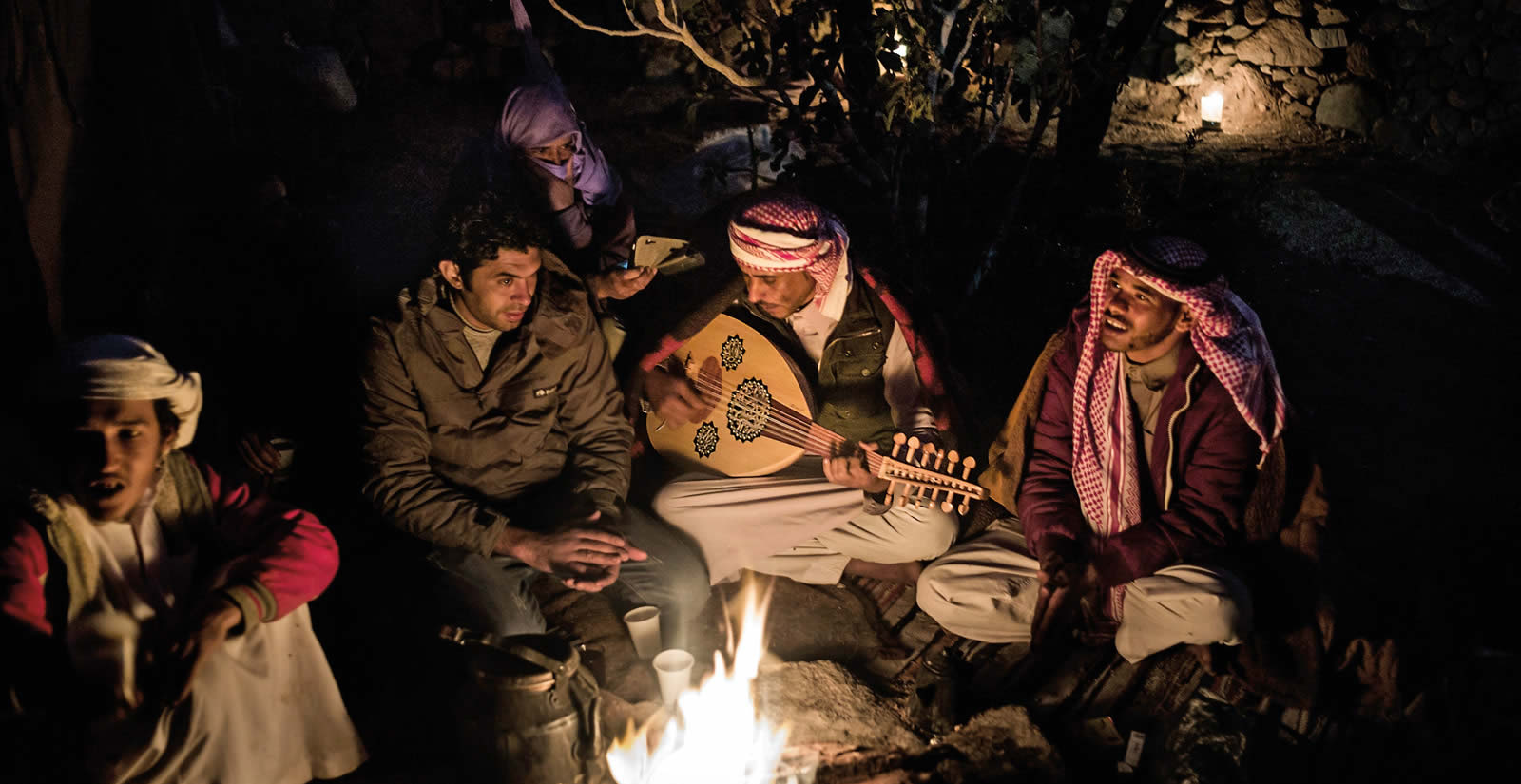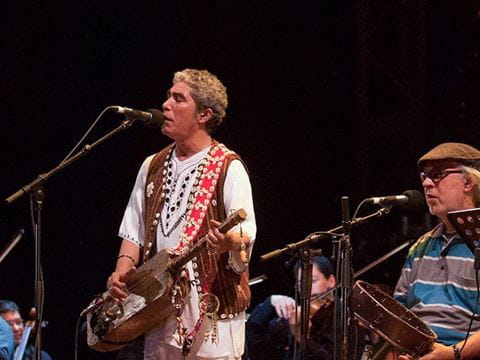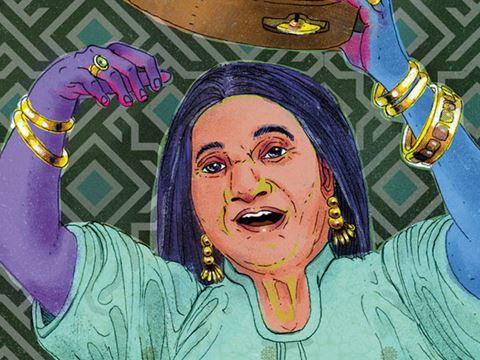
Prince of Enchantment: The Oud
Often regarded as the forerunner and name- sake of the European lute, the ‘ud (oud), is among the world’s oldest continuously played string instruments. In Arab and other musical traditions, its deeply resonant, emotionally evocative tones earned it, over the centuries, the sobriquet amir al-tararb.
“‘Uds differ from each other in their size, their smallness, their length, width and depth, in their forms, in quality, in crudity and by the elegance of correspondence of their different parts to one another.”
—Abu Yusuf al-Kindi, circa 870 ce

Sitting in his Pennsylvania workshop, surrounded by hanging tools and worktables, Najib Shaheen cradles a hand-crafted, wooden ‘ud (oud) in his arms. As he strums and picks, the nylon strings resonate along an Arab musical scale. Similar in size to an acoustic guitar but far different in shape and sound, the ‘ud is to many the most iconically Arab of all musical instruments. And Shaheen, whose expertise has earned him the nickname “Oudman,” would know.
Growing up in the Mediterranean coastal city of Haifa in the 1950s, the instrument has never been far from his reach. As a boy, he learned to play the round-backed, half-pear-shaped instrument amid an extraordinarily musical family. This included his father, Hikmat Shaheen, a well-known music educator, composer and ‘ud performer, and his younger brother Simon, who is today a virtuoso on both ‘ud and violin.

“Hundreds and hundreds of ‘uds passed through our house in those days. Every day there were four or five musicians coming and playing ‘ud,” Shaheen says, remembering how his father also made minor instrument repairs and that his uncle crafted ‘ud picks from goat horns. “And in the evenings, when the radio stations had to fill time between programs, the Shaheen house would stop to listen to a few minutes of ‘ud improvisation by the era’s great players.”
Soon he began learning the basics of woodworking after school at his grandfather’s carpentry shop, which would later beget a decades-long career.
When he arrived in New York in 1967, he says, players of his beloved instrument were mostly of Turkish and Armenian backgrounds.
“There was a vibrant nightclub scene with excellent singers and musicians,” he recalls, though outside of his musician’s community, “nobody knew what an ‘ud was.”
Shaheen spent years honing his craft, studying under ‘ud-maker Eddie Berberian, father of the well-known Armenian American ‘ud player John Berberian, before later apprenticing with New York-based luthier David Segal. Today, the Oudman is known for perfecting the acoustics on his clients’ ‘uds, and he is one of a few in what has become a much larger, much more diverse cultural scene committed to preserving and advancing the instrument’s craftsmanship and the sounds fast-plucking, virtuoso fingers can make.

For more than a thousand years, musicians across the Middle East, North Africa and southern Europe and Central Asia, much like members of the Shaheen family, have played the ‘ud for audiences large and small. It is frequently compared to the lute: Encyclopedia Britannica refers to the ‘ud as the “parent of the European lute” because of its fretless fingerboard, short neck and bent pegbox, as well as its similarities in pitch range. But its true derivation is quite an independent journey, and like most instruments, its history involves many varieties of ‘uds that have been developed through the centuries. These include the half-sized tuhfat al-‘ud as well as the narrower, longer-necked sister of the ‘ud, the kuwitra, which offers a smaller and shallower sound, four double strings, and it remains more common across the western regions of North Africa. The name lute itself, however, likely came from Arabic: al-‘ud, which rhymes with “food,” may have moved into Spanish as laud, and from there the change to lute would have been easy.
“It’s earthy and rounded, close to the cello,” Shaheen says. “And in a great instrument, there is an evenness of sound among all the strings.”
“It makes [people] weep when it sings, as though it / repeats to us what the doves have murmured in its ear.”
—al-Hilli, early-14th-century poet

Shaheen says the Middle East has long embraced the instrument as culturally emblematic, so much so it is often called amir al-tarab, “the prince of enchantment,” in a musical sense. Today, the instrument has a global following of avid listeners and dedicated musicians, including popular stars such as the late Farid al-Atrash of Syria, the late Egyptian-born Mohamed el-Qasabgi, Simon Shaheen, and Iraqi composer Naseer Shamma, who currently resides in Cairo.
But the greatest achievement of the ‘ud perhaps has been its own longevity. It has enchanted listeners through more centuries than perhaps any other stringed instrument. Its range spans three octaves, but that is a technical view, one that belies the deeper power of the ‘ud, the range of expression those octaves can achieve in the right hands. “It makes [people] weep when it sings, as though it / repeats to us what the doves have murmured in its ear,” wrote al-Hilli, a poet of the late 13th and early 14th century. Two hundred years earlier, poet al-Husayn praised its ability to express the pangs of the soul, “the pain of tribulation.”
At the same time, says George Sawa, an Egyptian-born and now Toronto-based scholar of Arab music history, “its sound is so warm, gorgeous and gentle, especially the low notes. There’s something about it that’s just magical.”

In addition, each design of the ‘ud is often a unique celebration of fine woodworking. For ‘ud builders like Shaheen, the ‘uds are opportunities to express creativity not only through acoustic design, but also through choices of wood and ornamentation.
The distinctively pear- or egg-shaped soundboard, he explains, is made from softwoods like spruce. One or three sound holes adorn it: The large one in the center is called shamsiyah (meaning from the sun) and it is often—but not always—flanked by two smaller ones called qamara (from the moon). These were traditionally decorated with elaborately carved bone rosettes, but today, wood and plastic do the job just as well. The bowled back frame is constructed from thin strips, or ribs, of hardwood. Above its unfretted neck, the tuning pegs for the strings are offset at an angle. The result is a remarkably lightweight instrument, averaging about a kilogram.
The ‘ud is picked with a rishah, a long, narrow plectrum often made of plastic or animal horn, though in the past an eagle quill was regarded as ideal. Rishah in Arabic means bird feather. Strings were once made from silk or gut, but most now are made with durable nylon, steel or silk covered in copper wire.
Rachel Beckles Willson, a professorial research associate at the School of Oriental and African Studies University of London, is currently working on a book about the history of the ‘ud. She explains the challenges of the undertaking.
“The ‘ud has become a significant cultural icon, which means that many groups of people want to claim it,” she says. “It’s caught up in national and regional historical claims, so its historiography carries those tensions.”
She continues, “Its name has a history that begins long after its existence, and its name encompasses many similar, but not identical, objects.”
The earliest forms of the ‘ud appeared in the second and first centuries bce. A commonly recited story about its origins, according to ninth-century ce scholar Abu Nasr Muhammad ibn Muhammad al-Farabi, attributes its invention to Lamech, an eighth-generation descendant of Adam. Al-Farabi says Lamech was inspired to build the instrument after seeing a vision for its shape in the bones of his deceased son, which were hanging—as in a period of mourning—from a tree. A more likely explanation may be found in the 14th-century writings of Abu al-Fida and Abu al-Walid ibn al-Shihnah, who placed the origins of the ‘ud between 270 and 240 bce, during the reign of Persian King Shapur i, though this, too, is mostly speculative.
Instruments with long necks with one or two strings do appear in early Mesopotamian and Egyptian iconography, though the first known image of a pear-shaped, short-necked, ‘ud-like instrument dates from a first-century ce relief in the Graeco-Bactrian city of Gandhara in present-day Afghanistan. In the centuries that followed, another short-necked string instrument, the barbat, took hold in Persia.
The ‘ud came to prominence in al-Hira, in what is now central Iraq, just south of Kufa. Capital of the Arab Lakhmid Kingdom from 300 to 602 ce, al-Hira gained a reputation for its literary and musical culture. In the late sixth century ce, when the ‘ud arrived in the Hijaz, in present-day western Saudi Arabia, musicians there were already playing other short-necked string instruments such as the kiran, the muattar and the mizhar, which were covered with animal skin.
In Arabic, ‘ud means “piece of the tree” or “piece of wood,” which may refer to its wooden sound board, its stem-like neck or to the wooden plectrum first used to play it. This may account for a description by 11th-century poet al-Qayrawani, who wrote, “From which branches grew and groves were fragrant … When the ’ud was green birds sang on it … When the ‘ud became dry, maidens sang on it.”
Though musicians continued playing the earlier instruments, the ‘ud gradually became the favorite, and further varieties followed. In eighth-century Baghdad, a musician named Zalzal introduced the ‘ud al-shabbut, perhaps referring to an ‘ud shaped like a large river fish of the Tigris and Euphrates. This was around the time the ‘ud was playing a leading role in the flowering of Arab music and culture that peaked beginning with the reign of Caliph Harun al-Rashid. ‘Ud players also provided entertainment for the wealthy.


It was also around this time that Muslim scholars approached the ‘ud using Greek musical concepts to explain Arab music theory. They studied the mathematical relationships among the notes and the maqamat (modes or scales) from Arab, Persian, Greek and Byzantine sources, proposing tunings and fret placements that used movable gut or string.
Over the centuries, scholars have classified ‘uds according to the numbers of strings on them. Some early instruments offered four, while modern ones offer six. The ‘ud al-qadim (old ‘ud), for example, had four strings. It was this design that was popular in ninth-century Baghdad, where the musician Ziryab added a fifth to make the ‘ud kamil (perfect ‘ud). Habib Hassan Touma, author of Music of the Arabs, explains that the four well-known strings were named after the Greek concept of the body’s four “humors,” but the fifth string “symbolized the soul, since the four body humors, as [Ziryab] maintained, could not exist without the soul.”
Later players added a second string to each of the five, creating a course, or a set of double strings, tuned identically, which added volume. By 1500, a six-course, ‘ud akmal (more perfect ‘ud) appeared, followed by the yet more-extended ‘ud mukamal with seven courses. In recent years, even an eight-course ‘ud has popped up. Today, however, most have five courses and a single bass string, for a total of 11 strings.

The stories of surviving antique ‘uds link to the instrument’s recent past, and Beckles Willson champions their stories in her research. A classically trained musician, composer and saxophonist, the professor traveled to Israel and Palestine in 2006 to research classical music in Arab communities. There she met Nizar Rohana, a musician and instrument collector.
She was thus introduced to the ‘ud, she recalls, “as something rich historically and also variegated, so every single instrument was different in size, shape, story, sound and type of decoration.”
She connects ‘uds with her experience in the region, equating their little-known musical stories with both the larger stories of the cultures of the region and more personal family stories like Shaheen’s.
Beckles Willson’s research led to ‘ud lessons, and also to founding oudmigrations.com, a website for sharing stories on historic ‘uds and musicians.
Oudmigrations.com collaborator Karim Othman Hassan writes about what may be the oldest existing ‘ud, now housed in the Musical Instruments Museum in Brussels. The Egyptian instrument arrived in Brussels in 1839, and it is an example of the seven-course ‘ud mukamal.

Well into the late 19th century, the ‘ud persisted in popularity as Arab music blossomed and, in the 20th century, transitioned into recordings and film. Virtuoso ‘ud players rose to celebrity on the airwaves, and ‘ud makers flourished too. Today, musicians and collectors have their prized ‘uds, and among them, the highest reputation is accorded those made by the Nahat family of Damascus from the 1870s to the 1980s. Their ‘uds are considered some of the best around, combining exquisite craft and outstanding sound. Over the generations the Nahat family made thousands of ‘uds, and many still exist. Shaheen attributes part of the Nahat family’s success to their proximity to high-quality instrument makers in Turkey and Europe.
“The Nahats set up the structural sound bracing of the ‘ud, and that’s what most Arab ‘ud makers use today,” Shaheen says.
To achieve their preferred range of sounds, ‘ud players consider a combination of features. And ‘ud makers will also customize instruments to the changing sound preferences of their clients. For example, Shaheen notes that some Arab players prefer Turkish ‘uds, while some Turkish ones prefer Arab ‘uds. Turkish ‘uds he explains, tune one note higher than Arab ‘uds, and Turkish ‘uds are built to withstand that higher tension, thus bringing out bright, higher tones. Arab ‘uds, which often feature elaborate inlay decorations around the sound holes and on the neck, can be wider and larger, and offer warmer, richer tones than their smaller counterparts.
‘Ud makers around the world now post videos of themselves working in their shops and playing their creations as part of a movement online that has aided the instrument’s long popularity. Teachers of the ‘ud share technique tips on YouTube, and dedicated students study with teachers continents away. Even for Shaheen, as he sits in his workshop, so far from his homeland and so many years removed from his childhood living room, where he once listened to stoppers-by playing the ‘ud, he continues to connect with other ‘ud enthusiasts worldwide. He is one of many Arab musicians carrying the story of the ‘ud into the future, and with every song his fingers direct, the tradition lives on another day.
You may also be interested in...

Nass El Ghiwane: Folk Musicians That Changed Morocco
Arts
This group of five young folk musicians became the voice of Morocco in the 1960s and beyond. Martin Scorsese called them “the Rolling Stones of North Africa,” but to Moroccans they were the sound of an entire generation in a charged moment of global pop culture.
Cheikha Remitti: The Voice of Rai Music In Algeria
Arts
Culture
Born in a village in northwest Algeria, Cheika Remitti sang high-energy songs of love, loss and society that pioneered rai music. Beloved by fans for more than 60 years until her death in 2006, her influence and popularity endure.
Albania Folk Music Performers Seek to Preserve Tradition
Arts
For centuries iso-polyphony, a style of folk singing, has chronicled Albanian life. The songs are part of a rich tradition, vital to weddings, funerals, harvests, festivals and other social events. Indeed, a Ministry of Culture official dubs it “the autobiography of a nation,” a means for the preservation and transmission of different stories. Recently, crowds gathered for the National Folklore Festival in the “stone city” of Gjirokastër, demonstrating that interest in iso-polyphony remains high. The challenge is getting younger generations to engage. But some are taking up the call.